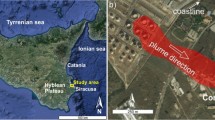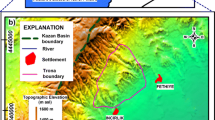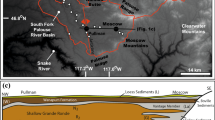Abstract
Yucca Mountain, Nevada is the site of the proposed US geologic repository for spent nuclear fuel and high-level radioactive waste. The repository is to be a mine, sited approximately 300 m below the crest of the mountain, in a sequence of variably welded and fractured mid-Miocene rhylolite tuffs, in the unsaturated zone, approximately 300 m above the water table. Beneath the proposed repository, at a depth of 2 km, is a thick sequence of Paleozoic carbonate rocks that contain the highly transmissive Lower Carbonate Aquifer. In the area of Yucca Mountain the Carbonate Aquifer integrates groundwater flow from north of the mountain, through the Amargosa Valley, through the Funeral Mountains to Furnace Creek in Death Valley, California where the groundwater discharges in a set of large springs. Data that describe the Carbonate Aquifer suggest a concept for flow through the aquifer, and based upon the conceptual model, a one-layer numerical model was constructed to simulate groundwater flow in the Carbonate Aquifer. Advective transport analyses suggest that the predicted travel time of a particle from Yucca Mountain to Death Valley through the Carbonate Aquifer might be as short as 100 years to as long 2,000 years, depending upon the porosity.
Resume
La montagne Yucca dans le Nevada est le site proposé aux Etats-Unis pour les dépôts géologiques des rejets de centrales nucléaires et des déchets radioactifs de haute activité. Ce site doit être une mine située environ à 300 mètres sous le sommet de la montagne, dans la zone non saturée de formations plus ou moins fracturées ou soudées de tufs rhylotites du Miocène moyen, approximativement à 300 m au-dessus du niveau de l’eau. Sous le site proposé, à une profondeur de 2 km, il existe une séquence épaisse de roches carbonatées qui contient le “Bas Aquifère Carbonaté” hautement transmissif. Dans le secteur de la montagne Yucca l’Aquifère Carbonaté rassemble le flux souterrain provenant du nord de la montagne, traversant la vallée d’Amargosa, de la montagne des Funérailles jusqu’au ruisseau de la Fournaise dans la Vallée de la Mort en Californie où les eaux jaillissent en plusieurs importantes sources. Les données qui décrivent l’Aquifère Carbonaté suggèrent un flux à travers l’aquifère et un modèle numérique monocouche a été construit à partir du modèle conceptuel pour simuler le flux d’eau souterraine au sein de l’Aquifère Carbonaté. Des analyses de transport advectif suggèrent que le temps de transit d’une particule allant de la montagne Yucca jusqu’à la Vallée de la Mort au travers de l’Aquifère Carbonaté pourrait varier, selon la porosité de la roche, de 100 et 2,000 ans.
Resumen
Yucca Mountain, Nevada es el sitio del repositorio geológico propuesto en EEUU para combustible nuclear usado y para residuos del alto nivel radiactivo. El repositorio debe ser una mina, situada a aproximadamente 300 m debajo de la cresta de la montaña, en una secuencia de tufas riolíticas fracturadas y variablemente selladas del Mioceno medio, en una zona no saturada, aproximadamente 300 m por encima del nivel freático. Por debajo del repositorio propuesto, a una profundidad de 2 km, se encuentra una secuencia espesa de rocas carbonáticas Paleozoicas que contienen el altamente transmisivo acuífero carbonático inferior. En el área de Yucca Mountain el acuífero carbonático integra el flujo de aguas subterráneas desde el norte de la montaña, a través del Valle Amargosa, a través de las Funeral Mountains al arroyo Furnace en el Valle de la Muerte, California donde el agua subterránea descarga en un conjunto de grandes manantiales. Los datos que describen el acuífero carbonático sugieren un concepto para el flujo a través del acuífero, y basado en el modelo conceptual se construyó modelo numérico de una capa para simular el flujo de aguas subterráneas en el acuífero Carbonático. Los análisis del transporte advectivo sugieren que el tiempo de tránsito predicho de una particular desde Yucca Mountain al valle de la Muerte a través del acuífero carbonático podría ser tan corto como 100 años a tan largo como 2,000 años, dependiendo de la porosidad.
摘要
内华达州的尤卡山是美国废弃核燃料和高放核废物的地质处置的候选场所。这个储库将会是一个位于山顶之下300m处的矿井, 在地下水位300m以上的包气带中, 围岩为复杂的裂隙型中中新世流纹凝灰岩。在储库下面, 即2km的深度上, 是一套水力传导率很高的厚层状古生代灰岩含水序列。在尤卡山地区, 灰岩含水层使来自山体北部的地下水通过Amargosa峡谷和Funeral山汇集到加利福利亚州死亡谷的Furnace河, 此处地下水以较大的泉的形式排泄。描述灰岩含水层的数据给出了一个通过含水层的水流的概念, 并且基于概念模型, 建立了一个单层的数值模型来模拟灰岩含水层中的地下水流。对流运移分析表明预测的一个微粒通过灰岩含水层从尤卡山到死亡谷的运移时间最快要100年, 最长要2000年, 这主要取决于孔隙度。
Resumo
A Montanha Yucca, no Nevada, é o local proposto nos Estados Unidos como armazém geológico para resíduos de combustíveis nucleares e outros materiais de elevada radioactividade. O repositório será uma mina, situada aproximadamente 300 m abaixo do cume da montanha, numa sequência de tufos riolíticos consolidados e fracturados do Miocénico médio, na zona não saturada, aproximadamente 300 m acima do nível freático. Por baixo do repositório proposto, a uma profundidade de 2 km, encontra-se uma espessa sequência de rochas carbonatadas do Paleozóico, contendo o Aquífero Inferior Carbonatado, de elevada transmissividade. Na área da Montanha Yucca, o Aquífero Carbonatado integra o escoamento subterrâneo proveniente da área a norte dessa montanha, através do Vale Amargosa e das Montanhas Funeral para o Ribeiro Furnace, no Vale da Morte, Califórnia, onde a água subterrânea descarrega num conjunto de grandes nascentes. Os dados que descrevem o Aquífero Carbonatado permitem conceptualizar o escoamento no aquífero e, baseado no modelo conceptual, foi desenvolvido um modelo numérico monocamada para simular o fluxo subterrâneo nesse aquífero. Análises relativas ao transporte advectivo sugerem que o tempo de trânsito previsível para uma partícula desde a Montanha Yucca até ao Vale da Morte, através do Aquífero Carbonatado, pode ser tão curto como 100 anos ou tão longo como 2,000 anos, em função dos valores da porosidade.














Similar content being viewed by others
References
Bedinger MS, Harrill JR (2006) Analytical regression stage analysis for Devil’s Hole: Death valley National Park, Nevada. J Am Water Resour Assoc 42:827–839
Belcher WR (ed) (2004) Death Valley regional ground-water flow system, Nevada and California: hydrologic framework and transient ground-water flow model. US Geol Surv Sci Invest Rep 2004-5205, 408 pp
Bredehoeft JD (1997) Fault permeability near Yucca Mountain. Water Resour Res 33:2459-2463
Bredehoeft J, Fredrick C, King M (2008) Groundwater flow through the Funeral Mountains, Death Valley National Park, California. Flow and transport processes, Proceedings International High-Level Radioactive Waste Meeting, American Nuclear Society, Las Vegas, NV, 7–11 Sept 2008, pp 5–13
Craig RW, Robison JH (1984) Geohydrology of the rocks penetrated by well UE25-25 P1, Yucca Mountain area, Nye county, Nevada. US Geol Surv Sci Invest Rep 94-4248, 57 pp
Eakin TE (1966) A regional interbasin ground-water system in the White River area, southeastern Nevada. Water Resour Res 1:251–271
Faunt CC, Blainey JB, Hill MC, D’Agnese FA, O’Brien G (2004) Transient numerical model, chap. F. In: Belcher WF (ed) Death Valley regional ground-water flow system: hydrogeologic framework and transient ground-water flow model. US Geol Surv Sci Invest Rep 2004–5205
Galloway D, Rojstaczer S (1988) Analysis and frequency response of water levels in wells to earth tides and atmospheric loading. Paper presented at 4th Canadian/American Conference on Hydrogeology, National Ground Water Association, Baniff, AB, Canada
Hubbert MK (1940) The theory of ground-water motion. J Geol 48:785–944
Mifflin MD (1968) Delineation of ground-water flow systems in Nevada. Report Series H-W, Publication No.4, University of Nevada, Desert Research Institute, Reno, NV, 109 pp
Pohlmann KF, Zhu J, Chapman JB, Russell CE, Carroll RW, Shafer DS (2008) Contaminant travel times from the Nevada Test Site to Yucca mountain: sensitivity to porosity. EOS Transactions, vol 89, American Geophysical Union, Washington, DC, 53 pp
Prudic DE, Harrill JR, Burbey TJ (1995) Conceptual evaluation of regional ground-water flow in the carbonate rock province of the Great basin, Nevada, Utah, and adjacent states. US Geol Surv Prof Pap 1409-D, 102 pp
Southern Nevada Water Authority (2006) Aquifer-properties data compilation and evaluation, vol 1. Presented to Office of the Nevada State Engineer, Reno, NV
Winograd IJ (1962) Interbasin movement of ground water at the Nevada Test Site. US Geol Surv Prof Pap 450C, pp C108–C111
Winograd IJ, Thordarson W (1975) Hydrogeologic and hydrochemical framework, south-central Great Basin, Nevada-California, with special reference to the Nevada Test Site. US Geol Surv Prof Pap 712-C, 126 pp
Acknowledgements
C. Faunt, of the USGS, assisted the authors by extracting the Paleozoic carbonate rock data from the USGS Regional Aquifer Model. Without her assistance this study was not possible. C. Fredrick, of the USGS, mapped the geology of Funeral Mountains, and assisted with the interpretation of the subsurface geology of Amagorosa Valley. The reviewers, especially D. Diodato, greatly sharpened the arguments in the paper.
Author information
Authors and Affiliations
Corresponding author
Rights and permissions
About this article
Cite this article
Bredehoeft, J., King, M. Potential contaminant transport in the regional Carbonate Aquifer beneath Yucca Mountain, Nevada, USA. Hydrogeol J 18, 775–789 (2010). https://doi.org/10.1007/s10040-009-0550-z
Received:
Accepted:
Published:
Issue Date:
DOI: https://doi.org/10.1007/s10040-009-0550-z




